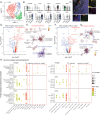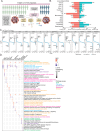Mature and migratory dendritic cells promote immune infiltration and response to anti-PD-1 checkpoint blockade in metastatic melanoma
- PMID: 40890106
- PMCID: PMC12402436
- DOI: 10.1038/s41467-025-62878-5
Mature and migratory dendritic cells promote immune infiltration and response to anti-PD-1 checkpoint blockade in metastatic melanoma
Abstract
Immune checkpoint inhibitors (ICIs) have revolutionized cancer therapy, yet most patients fail to achieve durable responses. To better understand the tumor microenvironment (TME), we analyze single-cell RNA-seq (~189 K cells) from 36 metastatic melanoma samples, defining 14 cell types, 55 subtypes, and 15 transcriptional hallmarks of malignant cells. Correlations between cell subtype proportions reveal six distinct clusters, with a mature dendritic cell subtype enriched in immunoregulatory molecules (mregDC) linked to naive T and B cells. Importantly, mregDC abundance predicts progression-free survival (PFS) with ICIs and other therapies, especially when combined with the TCF7 + /- CD8 T cell ratio. Analysis of an independent cohort (n = 318) validates mregDC as a predictive biomarker for anti-CTLA-4 plus anti-PD-1 therapies. Further characterization of mregDCs versus conventional dendritic cells (cDC1/cDC2) highlights their unique transcriptional, epigenetic (single-nucleus ATAC-seq data for cDCs from 14 matched samples), and interaction profiles, offering new insights for improving immunotherapy response and guiding future combination treatments.
© 2025. The Author(s).
Conflict of interest statement
Competing interests: The authors declare that they have no conflict of interest.
Figures






References
MeSH terms
Substances
LinkOut - more resources
Full Text Sources
Medical
Research Materials
Miscellaneous

